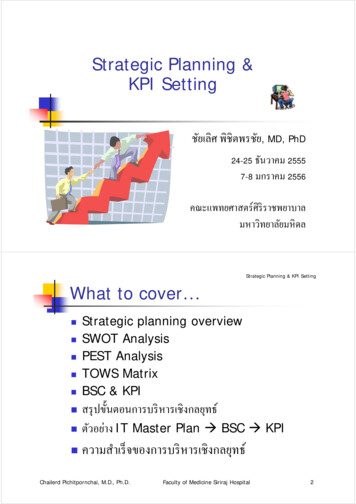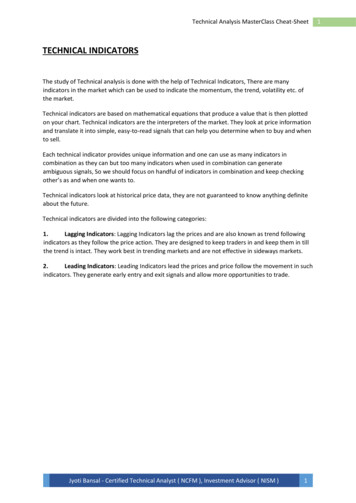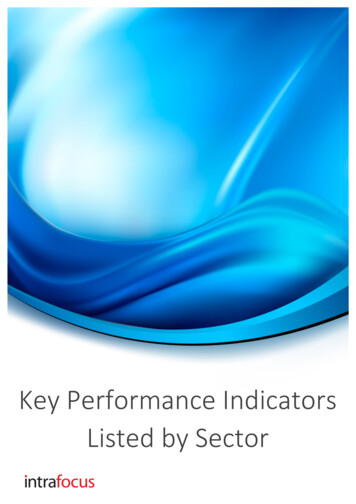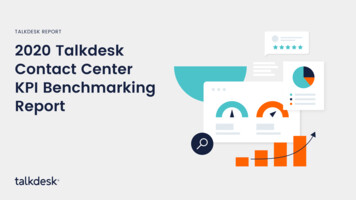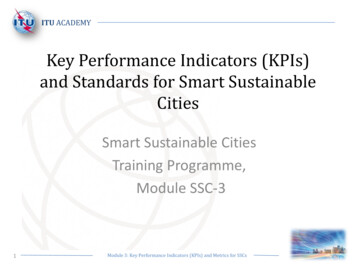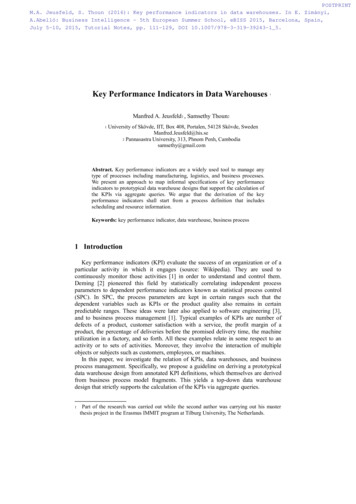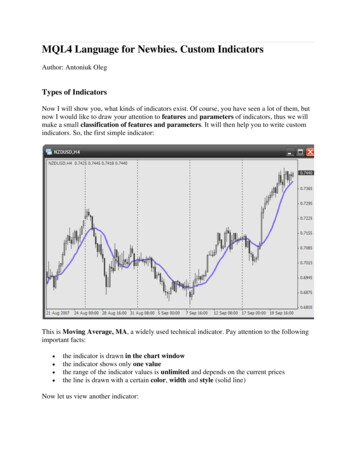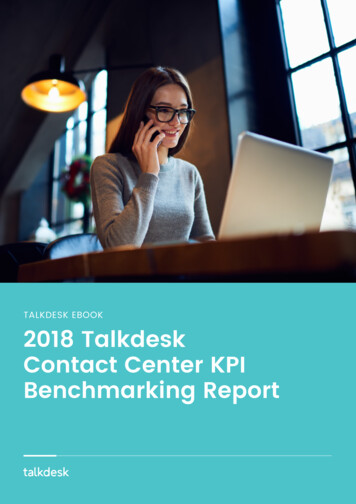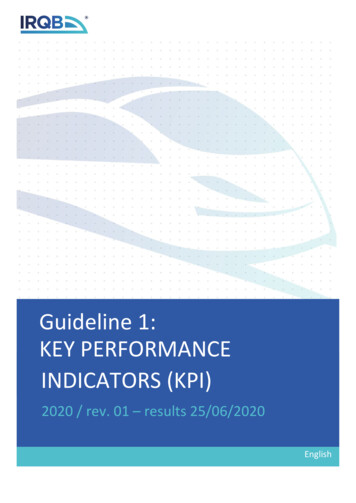
Transcription
Guideline 1:KEY PERFORMANCEINDICATORS (KPI)2020 / rev. 01 – results 25/06/2020English
Table of Contents1 Introduction . 02 Normative references . 13General concept of Key Performance Indicator (KPI) . 24Setting-up a KPI system. 24.1 Reflect the organisational objectives . 44.2 Apply SMART principles . 44.3 Fulfil the characteristic of well-defined KPIs . 45Implementing KPIs . 56Use of the Core IRIS-KPIs. 7Bibliography . 8ANNEX 1: IRIS Mandatory KPIs (ref. to clause 9.1.1.1) . 9This document and its contents are protected. This document contains confidential proprietaryinformation. The reproduction, distribution or communication of this document or any part thereof,without express authorization is strictly prohibited. Offenders will be held liable for the payment ofdamages. 2020. All rights reserved
1 IntroductionThis guideline provides: insights to help organizations to build a strong management approach as requested bycommon business management system standards, based on best practices from the railindustry,guidance to implement and maintain an IRIS certified business management systemconcerning the Key Performance Indicators (KPIs) required to comply with the ISO/TS22163:2017 requirements.The term KPI should be understood as generic in this guideline.Exceptional performance management starts with well-formalized processes and their associatedKPIs. These KPIs should be well-defined to enable common understanding of the metrics and providea transparent and accurate view for the periodical review according to the needs of the organization.This in turn feeds process reviews and management reviews which could trigger processimprovements, revision of the set of KPIs used or improvement in KPIs used to measure thoseprocesses.Figure 1: Performance Management SchemeThe IRIS certification system focuses more closely on the link between effective processes, KPIs andassociated management cycles, in order to enable conformity to standards and certificationrequirements in general and thus fulfilling customer needs.In addition, a well-defined KPI management system is a crucial pre-requisite to achieve the silverquality performance level as per IRIS certification conformity assessment.The KPI management system should indeed demonstrate high transparency on performance, whichshould be maintained and confirmed during the yearly IRIS audits (see IRIS certification conformityassessment).
Transparency can be characterized when the organization has set-up a KPI system with clearlydefined KPIs (and their associated processes) in the management system; whereby the KPIs areaccessible through an appropriate tool (e.g.: Excel, enterprise resource planning, businessintelligence tool). The organization should aim in the long run at automatizing, as much as possible,the data collection and consolidation, hence highly reducing the risk of misunderstanding of adefinition or adverse manipulation of data.The following are the main benefits of a strong KPI Management system: provide all stakeholders with an understanding of how they relate to the overall success ofthe organizationstrengthen the shared effort to reach common goals through periodic review & publicationof KPIsKPIs enable decision-makers to assess progress towards the achievement of intendedoutputs, goals, and objectivesKPIs enable to speak with data at any level in the organizationenable organizations to improve and influence their product qualitytransparency in budget controlTo conclude, in process-oriented organizations, the strategic goals of a company, whichever size itmay have or product/service it delivers, are reached through the implementation of an effective KPImanagement system, building on strong process management.This guideline addresses the following target groups: process owners and those working with the related sub-processesmanagement system responsiblebusiness performance responsibleThe guideline content is a recommendation based on good practices from the rail sector experts andmethods and is not subject to be audited by any third-party audit as a mandatory requirement.2 Normative referencesISO/TS 22163Railway applications – Quality management system – Businessmanagement system requirements for rail organizations: ISO 9001:2015and particular requirements for application in the rail sectorIRIS CERTIFICATION ConformityAssessment:2020Rules for achieving and maintaining IRIS Certification recognition
3General concept of Key Performance Indicator (KPI)A Key Performance Indicator, or KPI, is a metric that measures how well an organization performs abusiness activity that is critical for its current and future success: KEY: is important to evaluate the performance of the business management system.PERFORMANCE: only relating to performance when it can be clearly measured, quantified aswell as being sensitive to improvement by the organization.INDICATOR: an indicator provides fact-based information on a recorded performance andshould provide leading information on future performance or early signal.The KPI terminology should be understood as generic for any type of performance indicator.Depending on the organization, some KPIs can be important at several organization levels, from locallevel to executive management level.Effectiveness and efficiency are important parameters to be considered to identify the right KPIs: Efficiency: it is defined as the ability to produce something with a minimum amount of effortand resources. It is an important factor in the determination of productivity.Effectiveness: extent to which planned activities are performed and planned results areachieved. In contrast to efficiency, effectiveness is determined without reference to costs orresources.To efficiently and effectively develop and deliver solutions to the customer, it is needed to ensurethat processes are built, followed, sustained, and improved over time. In this respect, successfulprocess deployment is crucial to establish a common understanding and provide skills andknowledge needed to perform the process.In order to define process KPIs, it is important to determine the internal and external stakeholders ofthe related process and to identify and understand their requirements. These requirements shouldbe taken into consideration when defining KPIs.Figure 2: Deduction of KPIs out of Stakeholders’ requirementsOnly organizations that are able to define their relevant KPI based on the requirements of the customers of the processes(these might also be other processes within the same organisation),synchronise the definition with the customers of the processes,assure compliance with internal targets and customer expected results by regular andproper assessment of the KPI performance evolution,implement appropriate measures (where needed),will achieve a higher quality performance level sustainably.@ 2019. IRQB all rights reserved2 / 15
4Setting-up a KPI systemIt is important for an organization to define a robust KPI system, meaning the set-up by which thecompany vision and strategic objectives can be supported by an appropriate set of KPIs, used byexecutive management and cascaded, in coherence, down to local management in locations/plants.In addition, it is important that the organization defines which KPIs are needed for the IRIScertification (local level/executive HQ level) and ensure they are part of the KPI system. See details insection 3.For small & medium-sized organizations, it is key to ensure KPIs needed for the IRIS certification areknown and aligned both in plant/shop floor level as well as the executive committee level.Figure 3: Principles for establishing a KPI system in small/medium-sized organizationsFor large organizations with several locations/plants, it is key to well-define what KPIs are followedby executive management, middle management, as well as what is followed locally inprojects/sites/plants, ensuring the coherence from top to bottom.Figure 4: Principles for establishing a KPI system in large organizations
When appropriate, depending on the specific process, KPIs are based on data taken during thelifecycle of business projects. The defined measures for a process should be collected within projects(transversely, cross-sites) and then be aggregated to a higher level by the process owner to monitorthe process itself.The organization should define which KPIs will be reviewed at which level. Obviously, the mostcritical ones reviewed at CEO level and more operational KPIs (which contribute to the executiveKPIs) to be monitored locally.The selected KPIs would need to follow the three guiding principles below:4.1 Reflect the organisational objectivesIt is important to have KPIs that enable the follow-up of the strategic vision of the organization andlink them with the local operational performance and stakeholder expectations.Once an organization has analysed its vision, identified all of its stakeholders and defined itsobjectives, it needs a way to measure progress towards those objectives. Key PerformanceIndicators are those measurements.The definition of a KPI should consider the relevant stakeholders along the value stream to ensurean alignment of its objectives.4.2 Apply SMART principlesA KPI should follow the SMART criteria.Specific: it should be clear what exactly the indicator measures with one accepted definition. The KPIshould be linked to the process and its objectives.Measurable: the KPI should be quantifiable to state the actual value versus the target value.Achievable: it is important for the acceptance of the KPI that the target value is challenging butachievable. The desired level of performance should be realistic, even if challenging, taking intoaccount historical data that the organization has already gathered.Relevant: the KPI provides more insight into the performance of the organization or processes inbeing consistent with the business management system of the organization. A KPI is only relevant ifthe organization‘s processes and its stakeholders can influence it.Time framed: it is important to express the values of the KPI in a specified time frame.4.3 Fulfil the characteristic of well-defined KPIsA well-defined KPI should: be a simple concept: a KPI should speak for itself and be easily recognized in theorganization about what it measures.be easily connected to at least one of the three core drivers Quality, Time, Costs;be consolidated at all management levels: there is more value in the analysis of the KPI if itcan be consolidated from the working level up to the top management, so that eachmanagerial level can influence it;be sensitive to improvement: the choice of KPI and associated time scale should be made toallow the KPI evolution to be visible, so the organization can immediately take appropriateactions;be auditable: it should be possible to audit the KPI, by comparing how the tools/usercalculate a KPI vs. a reference document (KPI definition sheet);@ 2019. IRQB all rights reserved4 / 15
5be standardized: this is key especially for large organizations, where a KPI should bestandardized across all locations/businesses to enable common understanding and accuraterepresentation of the group’s total result;be capable of automatic retrieval and reporting: it is recommended to have KPIs which canbe calculated automatically (with no human intervention) to avoid errors/ interpretation andensure compliance to the KPI definition sheet;Implementing KPIsThe definition of each KPI, required in the frame of IRIS certification, should be in line with theISO/TS 22163 clause 9.1.1.1 a) to f) (see below).Specifically, regarding fulfilling IRIS certification requirements, the organization should clearlyindicate which KPIs measure the twenty-two (22) mandatory processes defined in the ISO/TS 22163and which KPIs measure the five (5) mandatory processes for performance evaluation.The following Table 1 shows recommendations on how to structure mandatory KPIs for performanceevaluation and have simple and effective communication on key requirements.ISO/TS22163ClauseProcess NameProcess Owner/Function in chargeProcessOverviewKPI Name(s)KPI definitionsheet(s)8.1.3ProjectManagementList here the processowner/organizational unitin charge of the processList here theprocess overviewreference to beusedList here the differentKPIs to be used toassess performance ofthe processList here theassociated KPIdefinition sheetreferenceEXAMPLEPMO-PRO-001EXAMPLEOn-Time Delivery %EXAMPLEPMO-KPI-001EXAMPLEHead of ProjectManagement Office8.28.38.48.5Requirements forproducts andservicesDesign anddevelopment ofproduct andservicesControl ofexternally providedprocesses, productsand servicesProduction andservice provisionTable 1 – Key information of the mandatory processes for performance evaluationAlso, the ten (10) mandatory KPIs defined in ISO/TS 22163 clause 9.1.1.1 g) to p) should be mappedto the twenty-two (22) mandatory processes respectively.This also applies to the eight (8) recommended KPIs according ISO/TS 22163 clause 9.1.1.1 i. to vii., ifused by organization.It is recommended that the organization formalizes its KPI definition sheets using the items providedin Table 2 below.
9.1.1.1Note: Items with (*) are mandatory according to ISO/TS 22163 chapter 9.1.1.1a)ItemExplanationExampleKPI titleWhat is the properdesignation of the KPI?What is to be achieved bythis KPI?defective purchased parts ratioTo which processes does thisKPI measure theperformance?Function/position/roleresponsible for the definitionand the implementation?How is the data calculatedand what unit is used formeasurement?What is the applicable scopeof items to be measured?What is to be used as a basisfor measurement/consolidation and reporting?process for purchased partsDefine what is the applicabletarget (and the target range),what period of time is usedfor the analysis, and where itcan be found.function/position/roleresponsible for dataconsolidation and reportingand frequency of KPIpublicationa) What is the reportingpath?b) At which level (reportinglevel)?desired target value and period: 2% ofdefective purchased signals per month)(e.g. target range: green 2%; yellow 2% to 4%; red 4%)(e.g. where described: budget review)responsible: supplier performanceanalystreporting frequency: monthlyPurpose /ImprovementgoalProcess *KPI ownerb)c)KPI definitionand calculation*Data source &tools used forconsolidationand reportingDesired targetvalues anddefined period *d)Responsible forreport andreportingfrequency *e)a) Reportingpath *b) Reportinglevelf)Responsible fordefining relatedactions *reduction of the number of defectivepurchased partsHead of Procurementnumber of defective purchased parts inrelation to all purchased parts(e.g. all purchased signals)stock inventory module of SAPa) goods receiving dept. purchasingdept. management(e.g. local level function)b) leaders/process owners divisionheads or head of operations CEO/executive committeecommodity manager or supplierdevelopment teamfunction/position/roleresponsible for definingrelated actions in casedesired target value is notmetTable 2: KPI definition sheet – mandatory and recommended standard items@ 2019. IRQB all rights reserved6 / 15
6Use of the core IRIS-KPIsThe following table 3 illustrates the different categories of the core KPI; some KPI are mandatoryaccording to the standard ISO/TS 22163 and the IRIS certification conformity assessment. Inaddition, the organization is free to choose the appropriate KPIs for the performance evaluation ofthe 5 mandatory processes (not necessarily new ones).These are mandatory KPIsRequested by ISO/TS 22163chapter 9.1.1.1 g) p)10 mandatory KPIsCustomer Satisfaction (9.1.2)Customer on time deliveryNonconformities raised bythe customer (8.7)Internal nonconformities(8.7)External providers’nonconformities (8.7)External providers’ on timedeliveryQuality deficiency costsProject costs (8.1.3.8)Requirements managementprocess (8.2.5)Design and Developmentprocess (8.3)Requested by IRISCERTIFICATION ConformityAssessment:2020 appendix 43 mandatory KPIs related tocustomer perceptionCustomer Satisfaction (9.1.2)Customer on time deliveryNonconformities raised bythe customer (8.7)The organization isfree to defineappropriate KPIsRequested by IRISCERTIFICATION ConformityAssessment:2020 appendix 65 mandatory PROCESSES forperformance evaluation project management(8.1.3)requirements forproducts and services(8.2)control of externallyprovided processes,products and services(8.4)design anddevelopment ofproducts and services(8.3)production andservice provision (8.5)Table 3: Core IRIS KPIsIt is recommended to have the KPIs in the above table as part of the KPIs illustrating the twenty-two(22) mandatory processes, in order to avoid a duplication of KPIs for the same topic. The selection ofthe KPIs for the five (5) mandatory processes for performance evaluation can include, as much aspossible, KPIs from the ten (10) mandatory KPI-list, but additional KPIs can be used to illustrate theperformance of those 5 processes.KPIs should be reviewed periodically in order to ensure they fit into the business needs and shouldalso be in line with the ISO/TS 22163 requirements.The periodical reviews should be done on all relevant levels of the organization to ensure constantfollow up and implementation of corrective actions on underperforming KPIs.The IRIS certification system supports these reviews as specified in the ISO/TS 22163 as well as in theIRIS certification conformity assessment (assessment methodology).Based on the requirements of the ISO/TS 22163, these reviews are considered in: Management reviews (clause 9.3), at least the ten (10) mandatory KPIs, andProcess reviews (clause 9.4) of the twenty-two (22) mandatory processes and related KPIs.
Following IRIS certification conformity assessment, core KPIs are needed in the data package for thelead auditor, to be made available at least sixty (60) days in advance (refer to Table 3), to: assess the five (5) mandatory processes for performance evaluation (IRIS CERTIFICATION Conformity Assessment:2020, appendix 6)assess the three (3) mandatory KPIs related to customer perception (IRIS CERTIFICATION Conformity Assessment:2020, appendix 4)Bibliography[1]IRQB Guideline 2: First Article Inspection[2]IRQB Guideline 4: RAMS/LCC[3]IRQB Guideline 5: Obsolescence[4]IRQB Guideline 6: Special processes[5]IRQB Guideline 7: Problem solving[6]IRQB Guideline 8: Configuration and change management@ 2019. IRQB all rights reserved8 / 15
ANNEX 1: IRIS mandatory KPIs (ref. to clause 9.1.1.1)The following table provides examples for the mandatory KPIs.There is no obligation to apply all examples! Each organization is free to define their own KPIs.KPI or ProcessnameCustomersatisfaction*IRISDefinition / Examplesclause9.1.2 Example 1: Parts returned by the customerratio of parts returned from the customer over number of totalparts delivered per periodExample 2: Average scoreaverage of score on questions in a customer satisfaction surveyrelated to key functions of a company (e.g. design, delivery,warranty etc.)Example 3: Timely feedbacks to customers after surveysaverage time (months) to provide full feedback to the customerafter survey performed (measured over x rolling months)Example 4: Net promotor scoreEvaluation of customer rating for the answer of the question: “Howlikely is it that you would recommend our company to a businesspartner?” e.g. customer rating on a scale from 1 to 10:1 to 6 (detractors), 7 to 8 (passives), 9 to 10 (promoters)Example 1: On time delivery of partsnumber of parts delivered to the customer on time divided bynumber of parts delivered to the customer (per period)Customer ontime delivery*Example 2: On time Delivery Index (OTD-percentage)number of customer deliverables on time divided by total amountof customer deliverables plannedNonconformitiesraised by thecustomer*8.7Note 1: Customer deliverables can include physical products,software releases, documentation, designs and drawingsNote 2: Customers can also be understood as internal customerswithin a companyExample 1: Nonconformities customerclaimed parts divided by delivered parts (per period)Example 2: Amount of incoming complaintsamount of incoming complaints per x rolling month divided byamount of incoming complaints of previous reporting periodExample 3: Nonconformity index at customer deliverydefects detected by customer during the final inspection but beforedelivery from the Sitenumber of A-defect x 100 number of B-defect x 25 number of Cdefect x 3 divided by (number of products delivered during the
KPI or ProcessnameIRISclauseDefinition / Examplesmonth)A-defect: Safety critical defectB-defect: Major non-functional issueC-defect: All other minor defectsExample 4: Complaint processing timeaverage time to close all related actions after the opening date(measured over x rolling months)Note: The KPI can apply to the whole complaint process or differentsteps within it.Internalnonconformities8.7Example 1: Right First Time (RFT)number of parts meeting the requirements at final inspectiondivided by number of parts final inspected (per period)Example 2: First pass yieldratio of "passed" tests over the total number of tests in the lastperiodExample 3: Software defectiveness after releasehours spent to close the defects identified after the release inrelation to total effort to develop the software-codeExample 4: Nonconformity index at final inspectiondefects detected during internal final inspectionnumber of A-defect x 100 number of B-defect x 25 number of Cdefect x 3 divided by (number of products delivered during themonth)A-defect: Safety critical defectB-defect: Major non-functional issueC-defect: All other minor defectsExample 5: Nonconformities processing timeaverage time to close all related actions after the opening date(measured over x rolling months)Example 6: Technical Quality Index (TQI)not accepted deliverables by the internal customer in relation tototal transmitted 7Example 1: Purchased parts failure ratenumber of nonconforming parts in relation to total number ofpurchased parts (per period)Example 2: Supplier related non-conformance-costsnon-conformance-costs caused by suppliers in relation to totalprocurement costsExample 3: Number of nonconformity reports issued to supplier per@ 2019. IRQB all rights reserved10 / 15
KPI or ProcessnameExternalproviders’ ontime deliveryIRISclauseDefinition / Examples1000 own production hoursratio between the number of supplier nonconformity reports issuedto suppliers by the entity during a period in relation to number ofproduction hours over the same period in the same entity xmultiplied by 1000.8.4.2.3 Example 1: Supplier on-time deliverynumber of parts received from supplier divided by number of partsconfirmed to be delivered by the supplier (per period)Example 2: Supplier delivery performance (OTIF)sum of on time in full purchase order schedule lines in relation tothe sum of expected schedule deliveries.Note: on time in full deliveries: lines totally delivered at planned date /- x working days”.Example 1: Rate of total cost of non-qualitysum of all costs related to scrap, rework and repair, modifications,penalties, extra warranty costs in relation to sales revenueQualitydeficiency costsExample 2: Claim and warranty coststotal costs of claim and warranty in relation to sales revenueExample 3: Internal non-conformity costs (scrap and rework)sum of all costs of scrap and rework in a plant in relation to thevalue of the WIP (Work In Progress) of productionExample 4: Non-conformance-costs before deliverynon-Conformance-costs (e.g. all kind of unplanned costs) beforedelivery in relation to the revenue of the productionProject costs8.1.3.4 Example 1: Deviation on final resultactual gross margin minus initially planned gross marginExample 2: Estimated At Completion (EAC) gross profit developmentdeviation of actual EAC gross profit to previous reporting periodExample 3: Cost management forecast accuracydifference between actual cost measured in month M versusforecast of costs for month M seen in month M-1Requirementsmanagementprocess8.2.5Design and8.3.1Example 1: Requirements coverage indexnumber of processed (analyzed, validated) tender/orderrequirements (technical, contractual, financial, legal ) in relation tothe total number of requirements in the request for quotationNote: The requirements coverage index can apply for the tenderphase as well for project realization phaseExample 1: Design Changesno. of design changes not initiated by the customer divided by no.
KPI or ProcessnamedevelopmentprocessIRISclauseDefinition / Examplesof design changes (per period)Example 2: Software defectiveness after releaseaverage no. of defects found after a software releaseExample 3: Design and development on timeno. of deliverables on time in relation to total planned deliverablesNote: Design and development deliverables can apply to high levelspecifications, interface documents, 3D-models, software releases,architecture documents, test procedures, hazard analyses, FMEAdocuments etc.Example 4: Quality of deliverablesno. of deliverables with open issues in relation to the number of alldeliverablesNote: Open issues could be hardware or software defects, notapproved documents etc. It might be helpful to rate the open issuesaccording to their severity.*) According to IRIS certification conformity assessment appendix 4, these KPIs are evaluated for thecustomer perception analysisNOTE: The definitions given in Annex 1 (IRIS KPIs) are for examples only. The organization may choosea different definition for the mentioned KPIs, if preferred.@ 2019. IRQB all rights reserved12 / 15
www.irqb.org info@irqb.org
objectives, it needs a way to measure progress towards those objectives. Key Performanc e Indicators are those measurements. The definition of a KPI should consider the relevant stakeholders along the value stream to ensure an alignment of its objectives. 4.2 Apply SMART pr

